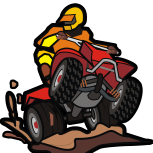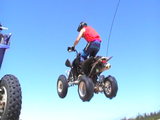ATV Front End Alignment How To
-
Similar Forum Topics
-
By mywifeknowseverythin
For those of you who are into coffee, I found this little article that might interest some of you.
I admit it. I am a coffee snob. I try not to be obnoxious about it, but let the record show: I enjoy a really great cup of coffee. But pay $4 a cup for it? No way. Even snobs have their limits.
Over the years, I’ve learned that a really good cup of coffee has less to do with money and more to do with knowledge and care. In fact—and this is the amazing thing—the more I learn, the less I spend.
BEANS. Purchase whole bean coffee as soon after it has been roasted as possible. Freshness is the key to a superb cup of coffee. Purchase in small amounts—only as much as you can use within 2 weeks of being roasted.
RATIO. The perfect ratio of coffee beans (prior to grinding) and water is: One-half cup whole beans to 8 cups of water.
GRIND. Grind your beans as close to brew time as possible. A burr or mill grinder that crushes the beans is preferable to a blade grinder that cuts them. Once ground, coffee should be used immediately.
WATER. If your water is highly chlorinated use bottled or filtered water. It must be right at 200 F, just short of boiling temperature, when it hits the dry grinds. This is critical to creating a great cup of coffee. Consume immediately.
STORE. The enemies of roasted coffee beans are air, moisture, heat and light—in that order. Keep your beans in an airtight container that is not close to moisture (sink, dishwasher), heat (oven, stove) or light (countertop). Do not store your daily coffee in the refrigerator or freezer because contact with moisture causes it to deteriorate. For larger quantities of roasted beans that you cannot use within 2 weeks, wrap in airtight bags and store for up to a month in the freezer—making sure the beans are completely protected against moisture. Once removed from the freezer, do not return.
BUY. Most supermarkets offer high-quality, roasted coffee beans for $.60 to $1 per ounce ($9.50 - $16.00 per pound). Ouch! Discount warehouse clubs like Costco, Sam’s and B.J.’s have considerably less expensive coffee at about $9 a pound for name brands like Starbuck’s and Peet’s. Still, that’s too rich for my blood.
ROAST. I roast my own coffee for two reasons: It is infinitely better tasting and half the price. I purchase green coffee beans by mail order for about $4 - $6 a pound, depending on current conditions and variety. I started out roasting in a popcorn popper (West Bend’s Poppery II is ideal) and have graduated to a small coffee roaster. My favorite resource for everything from roasting instructions to green coffee beans is http://www.u-roast-em.com/. Owner Jim Cameron has a wealth of knowledge and is anxious to share.
You won’t believe how easy it is to roast coffee. And enjoyable, too. I roast only one-week’s worth at a time—about twenty minutes. Green coffee beans have an indefinite, useful shelf life of at least a year, and probably two or longer. But I’ll never know. Coffee beans just don’t last that long around my house!
-
By Mikey69
Heres my story. Kinda long. I guess I was a late bloomer when it comes to quads. I had never ridden a quad in my life. Rode Dirt Bikes as a kid growing up. Back in Oct of '06 I found a Mustang on craigslist. Took it for a test drive one morning before work. Fast car. 351 Cleveland. I had planned on meeting the guy again after work. For some strange reason thats still to this day beyond me, I stopped in Hillsboro MotoSports on the way home from work. I had 6 Grand on me. There was a left over '05 sitting by the front door. It was on sale for $4999. It was $5499 OTD. I didnt even look at anything else. I knew nothing about quads accept I thought it really looked coool and I had the money in my pocket to buy it. I was sitting on it when the salesman walked up and asked... "Can I help you?" Without hestitation I pulled 60 Ben Franklins outta my front pocket and said "I want this Quad. Load it up in my truck." It was just about dark by the time I drove away from the shop. BTW, I didnt bother to ask my ol lady if I could buy it. LOL. Anyway, I took it by the house and showed her. She was kinda stunned but not mad. We drove over to a friend of mines house and unloaded it. I took it to the field across the street from his house. HOLY CHIT!!!!! I was surprised by the power. I had it for about 2 weeks and took it to Sand Lake. I was there a few hours and rolled it on a banked turn at the top of the bowl right before you get to the one-ways. When it rolled, I flew off and landed on my belly. The quad came bouncing and landed on my back. For a month I couldnt even walk. I was scared of it. I considered trading it for a 250EX. Went back to the shop. The salesman said..."Dude!!! You dont want a 250EX!!! Trust me. Just get used to it" I still wasnt convinced. I put it on craigslist for $4000. Calls were coming in. I had a guy that wanted to come look at it that evening. I decided to take it for one last ride at Browns Camp before I sold it. I was still afraid of it. After about 5 minutes I started feeling comfortable on it again. I decided right then, I loved my Honda 450 and would learn how to ride it instead of selling it. That was late Nov of '06. Work was slow for a Painter in Oregon. My new job everyday? Going to Browns Camp and ridding my Quad. I bought my Girl Friend an '02 Blaster. I rode my 450 for 4-6 hours almost every single day for 3 months. And yes, I know my way around Browns Camp pretty well. LOL. In March I bought her an '06 TRX250EX (Thank God I didnt trade my 450 for one of those) LOL Since then, I have become totally addicted to quads. I love them. Couldnt imagine not owning at least one quad. Luckily I have two. My "07 was $6500 OTD in July of '07. Bought it for my Girlfriend. Traded in her 250 EX. A month later we broke up. So, I wound up with two Honda 450's.
-
By STLJ
Hope everyone is having a great weekend,
While riding my quad just quit, I mean dead. No life on the dash, no crank and obesity no start.
Had a quick look under the plastic, batt reading 12.7v power at the key switch.
Changed the power pack, still no luck.
Anyone else have similar problems?
I don't see a fuse box/panel, is there fusible links in the system? If so where di I start looking?
SK
-
By Spritee1
polaris 2008 50 outlaw automatic: got the 50 for free. would only run with chock on, replaced the carburator with new. I can't get the unit to an idle where the machine doesn't move forward. if I do get it to idle down within a few moments it will die. got something to try?

-
By kawasig
Hello All
I'm kinda new to ATVs. I just bought a 1987 Suzuki quad runner 230 Dual Range. I'm having a problem finding info on it. It's very clean, only 2.800 miles. The front wheels are only 30 in.center to center. I was thinking about adding wheel spacers to give it more stability. I realize the added stress on ball joints and bearings. I'm wondering if there are any other concerns? Any input is greatly appreciated!
-








Recommended Posts
Join the conversation
You can post now and register later. If you have an account, sign in now to post with your account.
Note: Your post will require moderator approval before it will be visible.